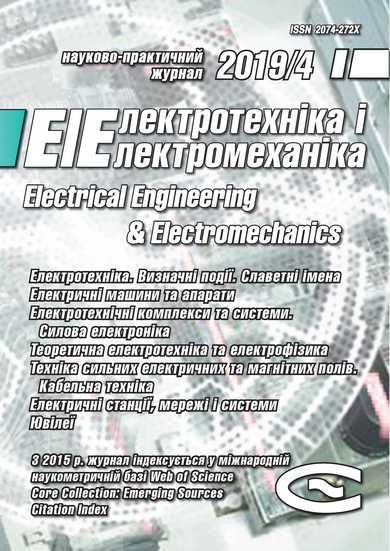IDENTIFICATION OF TECHNOLOGICAL DEFECTS IN HIGH-VOLTAGE SOLID INSULATION OF ELECTRICAL INSULATION STRUCTURES ON THE CHARACTERISTICS OF PARTIAL DISCHARGES
DOI:
https://doi.org/10.20998/2074-272X.2019.4.08Keywords:
technological defects, partial discharges, voltage of the start of partial discharges, glass-mica paper tape, amplitude of pulses of partial discharges, location of the defectAbstract
Introduction. High-voltage insulation systems always have some background level of the partial discharges, which does not have any significant effect on the life of the electrical insulation design. At the same time, partial discharges destroy high-voltage insulation, leading to a carburization zone around the defect. This is the «hidden» period of development of the defect. The development of a defect zone, sooner or later, leads to an arc breakdown of the entire insulating gap. Purpose. The substantiation of the efficiency of detection of technological defects in high-voltage solid insulation of electrical insulating structures according to the characteristics of partial discharges. Methodology. The conditions for the occurrence of partial discharges in the thickness of the polymer insulation are considered. The possible values of the voltage of the beginning of partial discharges are determined for a model of a cylindrical air gap near the conductor of a power cable. It is shown that with the same applied voltages to high-voltage insulation, in the latter case, air inclusions of smaller thickness are activated in comparison with a flat structure. Practical value. The efficiency of detection of technological defects in solid composite case insulation of the stator winding of turbo- and hydrogenerators is shown. Based on the comparison of the amplitude of the pulses of partial discharges of positive and negative polarity, the estimated location of the technological defects in the insulation has been established.References
Leonov V.M., Peshkov I.B., Ryazanov I.B., Kholodnyy S.D. Osnovy kabelnoy tehniki [Basics of cable technology]. Moscow, Akademiya Publ., 2006. 432 p. (Rus).
Bezprozvannych G.V., Mirchuk I.A., Kyessayev A.G. Technological parameters of the cooling mode of polymer insulation of power cables. Electrical engineering & electromechanics, 2019, no.3, pp. 44-49. doi: 10.20998/2074-272X.2019.3.07.
Rao Natti S., Shott Nik R. Tekhnologicheskie raschety v pererabotke plastmass [Technological calculations in plastics processing].Saint Petersburg, Professiya Publ., 2013. 200 p. (Rus).
Ogonkov V.G., Serebryannikov S.V. Elektroizoliatsionnye materialy i sistemy izoliatsii dlia elektricheskikh mashin. V dvukh knigakh. Kn. 2 [Electrical insulation materials and insulation systems for electrical machines. In 2 books. Book 2].Moscow, Publishing house MEI, 2012. 304 p. (Rus).
Pak V.M., Trubachev S.G. Novye materialy i sistemy izoliatsii vysokovol'tnykh elektricheskikh mashin [New materials and systems for isolation of high-voltage electrical machines].Moscow, Energoatomizdat Publ., 2007. 416 p. (Rus).
Bezprozvannych G.V., Boyko A.N., Roginskiy A.V. Effect of a dielectric barrier on the electric field distribution in high-voltage composite insulation of electric machines. Electrical engineering & electromechanics, 2018, no.6, pp. 63-67. doi: 10.20998/2074-272X.2018.6.09.
IEEE Standards 1434. Guide for the measurement of partial discharges in AC electric machinery. IEEE Park Avenue, New York, USA. 2014. 89 p.
CIGRE Working Group A1.01.06 Application. Of on-line partial discharge tests to rotating machines. CIGRE. December 2010. 58 p.
Iris Power TGA-BTM. Periodic On-line Partial Discharge Monitoring Using a Portable Instrument for Motors and High Speed Turbine Generators. Iris Power Ver 5. 08/10.Canada, 2010.
Interpretation of PD results – on-line testing. Version 3.2 Iris QMS 08/10. Ver. 3.2. 2008.
Shidlovsky A.K., Shcherba A.A., Zolotarev V.M., Podoltsev A.D., Kucheryavaya I.N. Kabeli s polimernoi izoliatsiei na sverkhvysokie napriazheniia [Polymer insulation cables for ultra-high voltages]. Kyiv, IED of NASU Publ., 2013. 552 p. (Rus).
Kuchinsky G.S. Chastichnye razriady v vysokovol'tnykh konstruktsiiakh [Partial discharges in high voltage structures].Leningrad, Energiia Publ., 1979. (Rus).
Vdoviko V.P. Chastichnye razriady v diagnostirovanii vysokovol'tnogo oborudovaniia [Partial discharges in diagnosing high-voltage equipment].Novosibirsk, Nauka Publ., 2007. 55 p. (Rus).
Naboka B.G., Bezprozvannych G.V., Gladchenko V.Ya. Method of measuring the differential amplitude spectra of partial discharge pulses. Electricity, 1990, no.1, pp. 71-74. (Rus).
Naboka B.G., Bezprozvannych G.V., Gladchenko V.Ya. Diagnostics of high-voltage insulation using multichannel analyzers. Electricity, 1991, no.5, pp. 5-9. (Rus).
Bezprozvannych G. V., Kessaev A. G. Analysis of the field structure and justification of the diagnostics voltage for partial insulation discharges of shielded twisted pairs. Electrical engineering & electromechanics, 2014, no.6, pp. 61-65. (Rus). doi: 10.20998/2074-272X.2014.6.11.
Bezprozvannych A.V. Waysof representation of differential peak spectra of pulses of partial discharges in solid insulation. Technical electrodynamics, 2011, no.4, pp. 12-19. (Rus).
Bezprozvannych A.V. High electric field and partial discharges in bundled cables. Technical electrodynamics, 2010, no.1, pp. 23-29. (Rus).
IEC Standard 60270. High-voltage test techniques – Partial discharge measurements. IEC, 2000. 55 p.
Downloads
Published
How to Cite
Issue
Section
License
Copyright (c) 2019 G. V. Bezprozvannych, A. G. Kyessayev, I. A. Mirchuk, A. V. Roginskiy

This work is licensed under a Creative Commons Attribution-NonCommercial 4.0 International License.
Authors who publish with this journal agree to the following terms:
1. Authors retain copyright and grant the journal right of first publication with the work simultaneously licensed under a Creative Commons Attribution License that allows others to share the work with an acknowledgement of the work's authorship and initial publication in this journal.
2. Authors are able to enter into separate, additional contractual arrangements for the non-exclusive distribution of the journal's published version of the work (e.g., post it to an institutional repository or publish it in a book), with an acknowledgement of its initial publication in this journal.
3. Authors are permitted and encouraged to post their work online (e.g., in institutional repositories or on their website) prior to and during the submission process, as it can lead to productive exchanges, as well as earlier and greater citation of published work.





